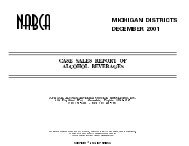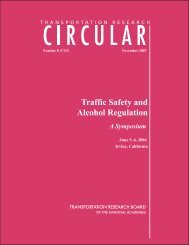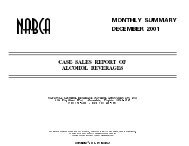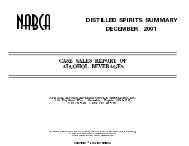Alcohol Policy Research and Alcoholic Beverage Control ... - nabca
Alcohol Policy Research and Alcoholic Beverage Control ... - nabca
Alcohol Policy Research and Alcoholic Beverage Control ... - nabca
Create successful ePaper yourself
Turn your PDF publications into a flip-book with our unique Google optimized e-Paper software.
Back to Table of Contents4.2 How does one determine an optimal balance of policies to provide fair access toresponsible drinkers while restricting sales in ways that reduce alcohol-related risks<strong>and</strong> harms? What methods are available for identifying best practices <strong>and</strong> theirapplicability to a particular state?Only recently has this research agenda—choosing the most cost-effective alcohol policy mix to fit theeconomic development <strong>and</strong> cultural conditions of a jurisdiction (including its rates <strong>and</strong> patterns of drinking<strong>and</strong> associated social <strong>and</strong> health harms)—begun to be seriously considered, <strong>and</strong> research in this area is justbeginning. Most of the thinking has had an international focus involving follow-ups to the efforts to examinemortality <strong>and</strong> disabilities resulting from alcohol use disorders (alcohol abuse <strong>and</strong> alcoholism) in the contextof World Bank <strong>and</strong> World Health Organization studies of the Global Burden of Disease. There are markedregional differences in the disease burden associated with alcohol. In the Americas (the region as a whole),alcohol has found to be the most important single preventable risk factor contributing to burden of disease,larger even than smoking, obesity, <strong>and</strong> high blood pressure.Regarding specific approaches to selecting an optimal set of alcohol policies for a jurisdiction there is notyet a solid, widely-endorsed methodology. Cost studies in the US help identify the larger contributors forexample, injuries, criminal justice, health system <strong>and</strong> alcohol treatment costs. Efforts at NIAAA to updatethese are currently underway, as are efforts to calculate disability adjusted life years associated with alcohol <strong>and</strong>related conditions using large-scale public data sources. In principle, by analogy to a country, a state’s profileof drinking patterns <strong>and</strong> harms, together with its population characteristics <strong>and</strong> economic <strong>and</strong> infrastructureresources, could help determine the relative expected effectiveness <strong>and</strong> cost effectiveness of various strategiesfor abating alcohol problems. Countries or states may both have different capabilities for implementingstrategies that strengthen policies to reduce drinking problems like increasing alcohol taxation, enhancingon- <strong>and</strong> off-premise point-of-sale regulations including retail monopoly practices where present, increasingenforcement of DWI laws or altering the legal BAC limits, increasing screening, brief intervention <strong>and</strong> referralto treatment (SBIRT) programs, <strong>and</strong> the like, <strong>and</strong> may also expect different results from such strategies if theyare implemented, depending on the country or state’s unique drinking patterns <strong>and</strong> resources. As discussedbelow, public sentiment for such legislative <strong>and</strong> regulatory measures may also affect the viability of particularapproaches. Although a beginning has been made, alcohol policy development (how to encourage passageof evidence based alcohol-related laws) remains more a political art than a science. It has been observed thatthe role of research tends to be more justificatory than initiatory, with some noteworthy exceptions such asmainly in the area of laws aiming to reduce drinking driving.Key Articles Cited In Section 4.2Anderson, P., Chisholm, D., & Fuhr, D. C. (2009). Effectiveness <strong>and</strong> cost-effectiveness of policies<strong>and</strong> programmes to reduce the harm caused by alcohol. Lancet, 373(9682), 2234-2246.This is an extremely comprehensive, current review of the evidence for effectiveness of alcohol policies<strong>and</strong> programs, one of several Lancet papers in this edition focused on <strong>Alcohol</strong> <strong>and</strong> Global Health. It isbroadly framed for relevance to both developed <strong>and</strong> developing countries, <strong>and</strong> most often it cites recentkey reviews on particular alcohol policy topics. It breaks policies considered into 9 “target areas”: (1)Education <strong>and</strong> information, (2) Health-sector Response, (3) Community programs, (4) Drink-driving policies<strong>and</strong> countermeasures, (5) Addressing the availability of alcohol, (6) Addressing the marketing of alcoholicbeverages, (7) Pricing policies, (8) Harm reduction <strong>and</strong> (9) Reducing the public health effect of illegally <strong>and</strong>informally produced alcohol. In addition to marshalling current evidence of effectiveness it notes that studiesof social costs have been done in many countries, addressed by Rehm et al., in a companion Lancet article90Back to Table of Contents








